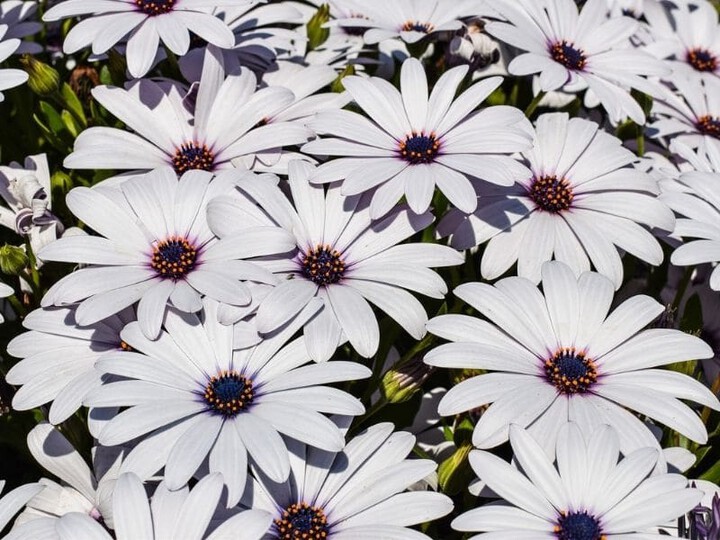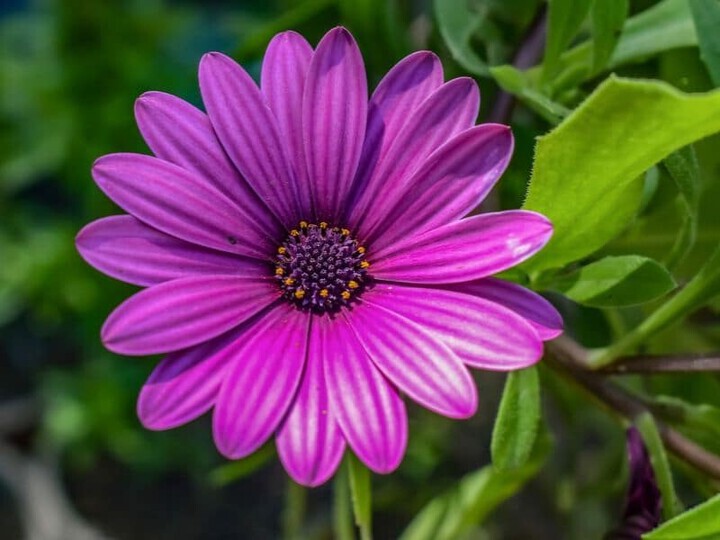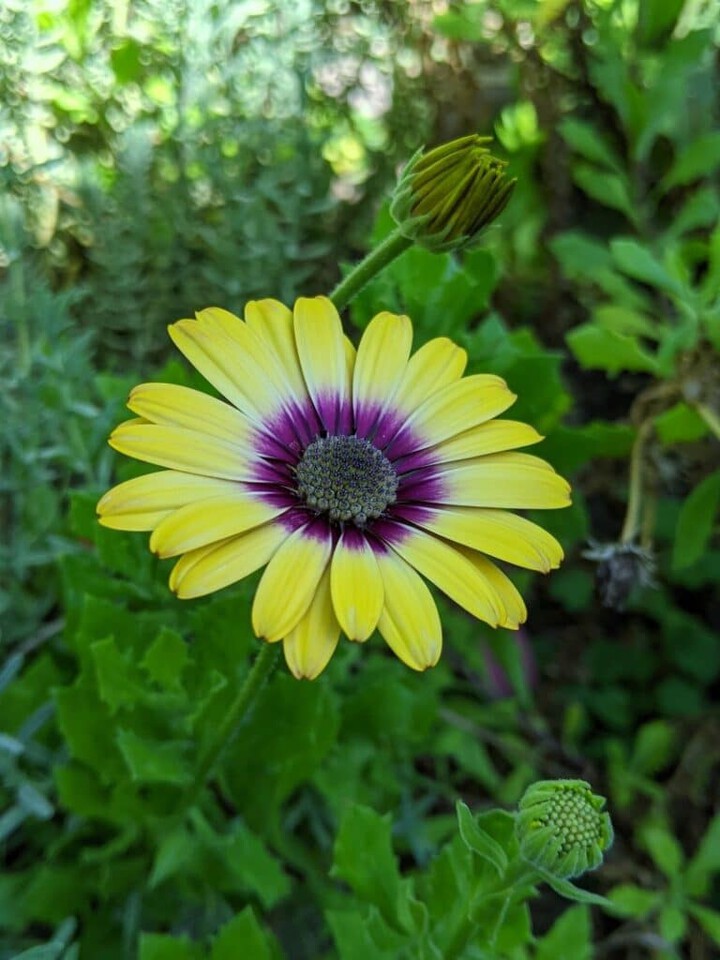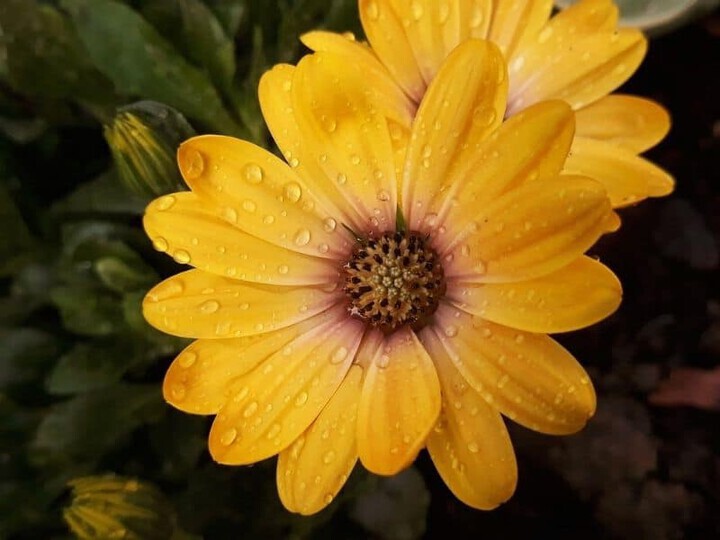African daisies can make a vibrant addition to your garden, but a warm climate is necessary. The African daisy originates from Africa, and requires a similar climate to grow, even as an annual. These flowers will not tolerate frost—at all—and will die at the first hint of frosty weather.
Although African daisies have a similar growth pattern and stature of a traditional daisy, the colors are much brighter—they almost look fake.

Growing African daisies in your garden or around your property is a sure way to add some bright colors. Many will grow these flowers as a contrast to other, less colorful flowers in their garden.
What Are African Daisies?
African daisies are scientifically known as Osteospermum and are a part of the Asteraceae family. The Asteraceae family consists primarily of other daisy varieties and is one of the largest flowering plant families.
There are different varieties of Osteospermum, and they all require high temperatures and full sun.
The USDA hardiness zones for African daisies are nine through ten, leaving many people out in the cold when it comes to planting these flowers outside. Although African daisies can be perennials, they are generally only grown as annuals.

Even in ideal climates, these flowers are considered tender perennials, making them at-risk for not coming back another year if proper temperatures are not kept. To avoid any loss of flowers, many plan on digging up and replanting their African daisies every year.
They say the flowers on the African daisy look like fake flowers or dyed flowers. The colors are exceptionally vibrant and eye-catching and come in pinks, purples, whites, yellows, and some multi-color combinations of these colors.
The blooms on most varieties will start in mid-spring, with the peak being late spring to early summer. Blooms generally continue through the end of summer, sometimes into early fall.
Varieties of African Daisies You Can Grow
When it comes to choosing a variety of African daisy to plant in your garden or landscaping, the most important factor to consider are the colors you want. Some varieties also have specific characteristics that may work better for your situation than others.
Whichever varieties you choose, the beautiful and brightly colored flowers are sure to add some vibrant life around your home.
Osteospermum 4D Silver
The Osteospermum 4D silver has bright white petals that have an almost silver tint to them. The centers on these flowers are a lavender purple which contrasts nicely against the white petals. The flower heads on this variety are also said to be bushier than other varieties of the African daisy.
While most varieties of osteospermum close their flowers during the night, the 4D variety remains open throughout the day and night and only closes once the flowers die.
Osteospermum Lemon Symphony
The lemon symphony variety has bright yellow flower petals that surround a deep purple center, adding to the contrast effect of these flowers. This is a common choice for container gardening and for bouquets and is generally paired with flowers that are purple in color.
This variety is particularly heat-resistant and can grow in USDA hardiness zone eleven, while most other varieties do best in nine through ten. These yellow flowers thrive in the heat and will do well in the hottest of summers.
Osteospermum Passion Mix
The osteospermum passion mix is one of the more commonly planted varieties as it is one of the most popular.
You can find pink, purple, and white flowers in this variety, all with an intense vibrancy. This variety is more compact than others and tends to be shorter with bunches of flowers that are closer together.
The passion mix variety was bred to be heat resistant and—along with the lemon symphony variety—can be grown in zone eleven, along with nine and ten. You won’t need to worry about hot temperatures with these flowers, they are built to withstand brutal temperatures.
Osteospermum Copper Apricot
The copper apricot variety has bi-colored flowers that are an apricot orange color towards the tip of the petal that gradually turns into a bright pink towards the center. The eye of the flower is usually a brownish orange color that pops against the pink base of the petals.
Although African daisies generally perform best in full-sun environments, the copper apricot is said to grow fine in partial-shade locations. If you have a partially-shaded area and are considering planting African daisies, the copper apricot may be a good choice for you.
Osteospermum Spider White
The osteospermum spider white is perhaps one of the most unique varieties of African daisies available. Unlike a traditional daisy petal, the petals on the spider white have a spoon-like shape.
The petal is crimped about halfway up and the tips of the petals curve inward similarly to the head of a spoon. These petals are a bright white color with a deep purple center. The crimped portion of the petal may have some purple coloration in it as well.
Besides the uniqueness of the flowers, there is not much that stands out when it comes to caring for this variety of African daisy. These plants will behave similarly to any other African daisy.

A picture of yellow African daisy with purple center
How to Care for African Daisies
Overall, African daisies are fairly simple plants to care for. To ensure the highest number of blooms and the healthiest plants, there are some actions that can be taken, however.
A well cared for African daisy will produce brightly colored blooms all season long and is sure to be a favorite.
Sun Exposure
When choosing a location to plant your African daisies, full sun is always best. A full-sun location will provide your plants with the energy they need to produce high numbers of blooms.
A partially-shaded location may be an option for your African daisies, but you may reduce the number of blooms you receive by doing so.
Most varieties of African daisies will close up their flowers overnight, storing energy for the next day. If you want your flowers open 24/7 the 4D varieties do not close up and will have beautiful blooms available at night and during the day.
Water
Like all the flowers in the world, you need to know how to water them. As a general rule, watering your African daisies once a week should supply them with ample amounts of water, without going overboard.
A minimum of one inch of water a week is what these flowers require, so if you are not receiving much rain, it may be a good idea to give them an extra watering to ensure they do not dry up.
In a worst case scenario where your African daisies are not receiving any water for a period of time, they are drought resistant. Being drought resistant may keep the plant alive without water availability, but the flowers will close up in an effort to conserve energy.
Soil
Well-drained soil is important to the African daisy as they are prone to root rot which is caused by too much water on the roots. Soil that drains water well will ensure you do not have puddles of water forming around your roots—this can be deadly to the plant.
Soil with a high nutrient content is also preferred by the African daisies. If your soil is not high in nutrients, organic materials and fertilizers can be added to give your flowers a boost.
Although not crucial, a pH between 5 and 5.5 is ideal for these plants. There are fertilizers available to help attain these pH levels in your soil if it is too acidic or too basic.
Pruning
There are a few pruning tips to consider when growing African daisies. The first is called pinching, which is exactly what it sounds like.
This method involves pinching off new growth as it arises to promote more horizontal growth, making the overall plant bushier. Do not pinch excessively, as this can delay blooming and even harm the plant over time.
Another pruning method to consider is deadheading the spent flowers. Deadheading is as simple as pulling off the flower heads once they are finished blooming and are dead.
Some people choose to use small pruning shears to deadhead while others simply pull them off with their fingers. Deadheading promotes the growth of new flowers by eliminating flowers that have already bloomed and died.
African daisy plants can start to outgrow their original area by growing either too tall or too wide—particularly in mid-summer. If your plant starts to get a little bit out of control, you can start to cut off new growth as it starts to grow.
Eliminating new growth that is growing in an undesirable direction can promote growth in more desired areas. Removing portions of the plant can even make it healthier overall—assuming you do not go overboard.
Fertilizing
Since most African daisies are grown as annuals, fertilizers can be an important part of caring for your plants. Especially when grown in containers, you should be fertilizing your African daisies every two or three weeks depending on the time of the season.
When the blooms are at their peak, fertilizing more frequently can promote more blooms that last longer. When the plant is not in full-blooming mode, you won’t need to fertilize as often.
Fertilizers that are water soluble are best for the African daisy. Although there are many different fertilizers to choose from, an organic fertilizer designed for blooming flowers will probably be your best bet if you want the best blooms possible.

Common Diseases and Pests
Although African daisies are relatively tough plants, there are some diseases and pests to be on the lookout for. Preventative actions and early detection are important if you want to keep your plant in its healthiest condition.
Aphids
Aphids are one of the most common pests that you will have to deal with when planting almost anything.
Particularly in warmer climates, aphids will attach themselves to the leaves of a plant and will suck the nutrients, leaving dead spots and sometimes holes, causing damage to the plant.
The simplest solution to an aphid problem is to mix dish soap and water together in a spray bottle and spray infected areas once daily for two to three weeks. If this does not take care of the situation, introducing lacewing insects into your garden may be the next step.
Lacewings will effectively eat the aphids while leaving your plants unharmed—not all insects are bad!
Whitefly
Whiteflies have a similar effect on plants that the aphids do; they will start by sucking the nutrients from the foliage, killing leaves over time. Whiteflies will grow larger than aphids, and they can end up causing more damage as they grow and multiply.
To get rid of whiteflies, you may want to consider sticky traps that effectively trap and kill the adults. To get rid of the larvae, a light pesticide can be applied as needed. Introducing lacewings into your garden will help to remove the larvae once you eliminate the adult population.
Gray Mold
African daisies are particularly susceptible to gray mold because it will form in damp and humid conditions, much like the environment within which African daisies will grow.
Gray mold is a fungus that will start to harm the plant over time and can eventually cause the plant to die if no intervention is taken.
Proper air circulation between the foliage is a good preventative measure. If gray mold starts to form, applying a fungicide early on can help control the issue before it becomes a problem for the plant’s health.
Root Rot
Root rot is a common problem for African daisies if they do not have proper drainage in the soil.
African daisies are particularly prone to root rot because they are built to be drought resistant. An overabundance of water will overwhelm the root system and, over-time, can cause it to go soft and rot.
Once root rot is detected, the plant should either be transplanted to a dry location with better drainage, or drainage should be added to the location within which it is currently planted.
If the roots have rotted to the point where they are mushy to the touch, the plant may not be able to be saved. Preventative measures for the following season should be taken, especially if your plants have suffered from root rot in the past.